39 Fastest Organisms on Earth
Though it is pretty difficult to compute the exact speed of all organisms on the earth, still there are some amazing facts about fast animals on the earth. When it comes to quickness, speed, and fluidity, nothing can be compared to these creatures that rule on land, in the air, and in the water. Their bodies, fins, wings, and legs are super strong that are meticulously designed by nature so that they can hunt and survive in their highly competitive environments. Indeed, speed is important in the animal kingdom since it simply means the difference between death and life. So here’s the list of fastest organisms on earth that use their speed to overpower their prey and eat the delicacy and also to avoid becoming food of other predators. And some of these animals whirl through water, some flutter through the air, and some sprint on land.
Peregrine falcon
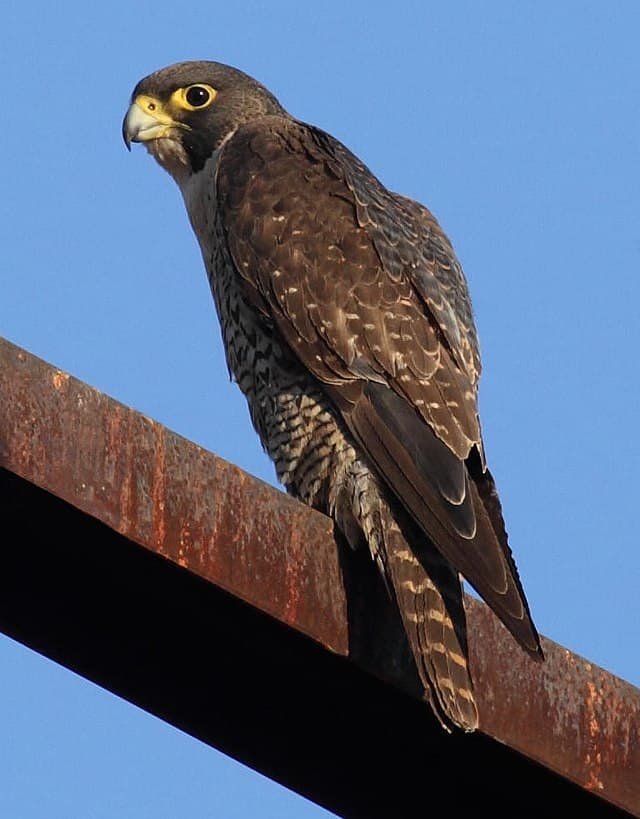
389 km/h
The peregrine falcon (Falco peregrinus), also known as the peregrine, and historically as the duck hawk in North America, is a widespread bird of prey (raptor) in the family Falconidae. A large, crow-sized falcon, it has a blue-grey back, barred white underparts, and a black head. The peregrine is renowned for its speed, reaching over 320 km/h (200 mph) during its characteristic hunting stoop (high-speed dive), making it the fastest bird in the world, as well as the fastest member of the animal kingdom. According to a National Geographic TV program, the highest measured speed of a peregrine falcon is 389 km/h (242 mph). As is typical for bird-eating raptors, peregrine falcons are sexually dimorphic, with females being considerably larger than males.The peregrine’s breeding range includes land regions from the Arctic tundra to the tropics. It can be found nearly everywhere on Earth, except extreme polar regions, very high mountains, and most tropical rainforests; the only major ice-free landmass from which it is entirely absent is New Zealand.
Read More About Peregrine falcon / Source
White-throated needletail

169 km/h
The white-throated needletail (Hirundapus caudacutus), also known as needle-tailed swift or spine-tailed swift, is a large swift in the genus Hirundapus. It is reputed to reach speeds of up to 170 km/h (105 mph) in horizontal flight, but this is unverified because the methods used to measure its speed have not been published.They build their nests in rock crevices in cliffs or hollow trees. They do not like to sit on the ground and spend most of their time in the air. They feed on small, flying insects like beetles, flies, bees and moths.The white-throated needletail is a migratory bird, breeding in Central Asia and southern Siberia, and wintering south in the Indian Subcontinent, Southeast Asia and Australia. It is a rare vagrant in Western Europe and has been recorded as far west as Norway, Sweden and Great Britain. In June 2013, an individual was spotted in Great Britain after 22 years. It later flew into a wind turbine and died; its body was sent to a museum.White-throated needletails are large swifts with a robust, barrel-like body. They measure about 20 cm and weigh between 110 and 120 grams. They are greyish-brown except for a white throat and a white patch, extending from the base of the tail to the flanks.Needle-tailed swifts get their name from the spined end of their tail, which is not forked as it is in the typical swifts of the genus Apus.
Read More About White-throated needletail / Source
Eurasian hobby
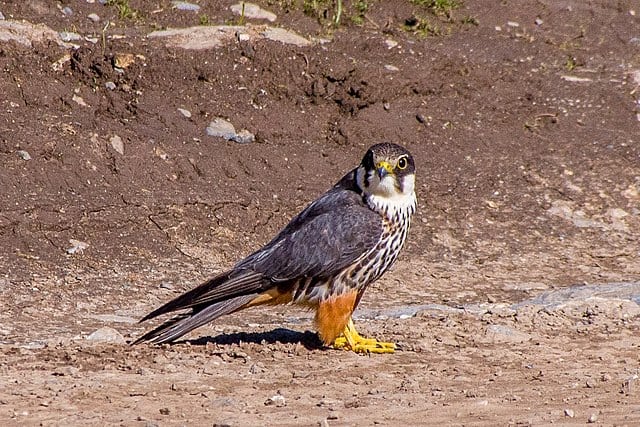
160 km/h
The Eurasian hobby (Falco subbuteo) or just simply hobby, is a small, slim falcon. It belongs to a rather close-knit group of similar falcons often considered a subgenus Hypotriorchis. The first formal description of the Eurasian hobby was by the Swedish naturalist Carl Linnaeus in 1758 in the tenth edition of his Systema Naturae under the present binomial name Falco subbuteo. The genus name falco derives from Late Latin falx, falcis, a sickle, referring to the claws of the bird. The species name subbuteo is from Latin sub, “near to” and buteo, ” buzzard” . The species’ English name comes from Old French hobé or hobet. It became the trademark for the Subbuteo games company after its creator, who was an ornithologist, was refused permission to register “Hobby”.
Read More About Eurasian hobby / Source
Mexican free-tailed bat
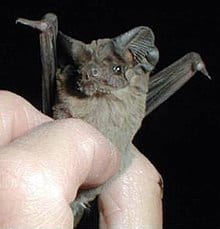
160 km/h
The Mexican free-tailed bat or Brazilian free-tailed bat (Tadarida brasiliensis) is a medium-sized bat native to the Americas, regarded as one of the most abundant mammals in North America. Its proclivity towards roosting in huge numbers at relatively few locations makes it vulnerable to habitat destruction in spite of its abundance. It has been claimed to have the fastest horizontal speed (as opposed to stoop diving speed) of any animal, reaching top ground speeds over 101 mph (162 km/h); its actual air speed has not been measured. The Texas Legislature designated the Mexican free-tailed bat the state mammal (flying) in 1995.
Read More About Mexican free-tailed bat / Source
Frigatebird
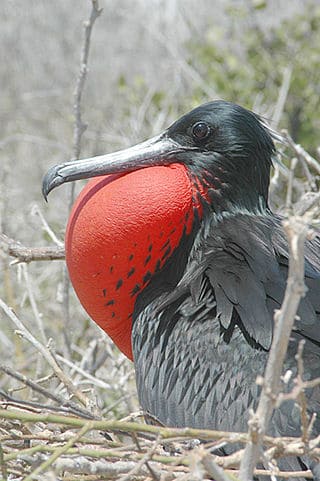
153 km/h
Frigatebirds (also listed as “frigate bird”, “frigate-bird”, “frigate”, “frigate-petrel”) are a family of seabirds called Fregatidae which are found across all tropical and subtropical oceans. The five extant species are classified in a single genus, Fregata. All have predominantly black plumage, long, deeply forked tails and long hooked bills. Females have white underbellies and males have a distinctive red gular pouch, which they inflate during the breeding season to attract females. Their wings are long and pointed and can span up to 2.3 metres (7.5 ft), the largest wing area to body weight ratio of any bird.
Able to soar for weeks on wind currents, frigatebirds spend most of the day in flight hunting for food, and roost on trees or cliffs at night. Their main prey are fish and squid, caught when chased to the water surface by large predators such as tuna. Frigatebirds are referred to as kleptoparasites as they occasionally rob other seabirds for food, and are known to snatch seabird chicks from the nest. Seasonally monogamous, frigatebirds nest colonially. A rough nest is constructed in low trees or on the ground on remote islands. A single egg is laid each breeding season. The duration of parental care is among the longest of any bird species; frigatebirds are only able to breed every other year.
Read More About Frigatebird / Source
Rock dove

148 km/h
The rock dove, rock pigeon, or common pigeon ( also ; Columba livia) is a member of the bird family Columbidae (doves and pigeons). In common usage, this bird is often simply referred to as the “pigeon”. The domestic pigeon (Columba livia domestica, which includes about 1,000 different breeds) descended from this species. Escaped domestic pigeons have increased the populations of feral pigeons around the world.Wild rock doves are pale grey with two black bars on each wing, whereas domestic and feral pigeons vary in colour and pattern. Few differences are seen between males and females. The species is generally monogamous, with two squabs (young) per brood. Both parents care for the young for a time.Habitats include various open and semi-open environments. Cliffs and rock ledges are used for roosting and breeding in the wild. Originally found wild in Europe, North Africa, and western Asia, pigeons have become established in cities around the world. The species is abundant, with an estimated population of 17 to 28 million feral and wild birds in Europe alone and up to 120 million worldwide.
Read More About Rock dove / Source
Ostrich

96 km/h
Struthio is a genus of birds in the order Struthioniformes, whose members are the ostriches. It is part of the infra-class Palaeognathae, a diverse group of flightless birds also known as ratites that includes the emus, rheas, and kiwis. There are two living species of ostrich, the common ostrich and the Somali ostrich. They are large flightless birds of Africa who lay the largest eggs of any living land animal. With the ability to run at 70 km/h (43.5 mph), they are the fastest birds on land. It is farmed worldwide, particularly for its feathers as they are used as decoration and feather dusters. Its skin is also used for leather products.
Read More About Ostrich / Source
Horse-fly
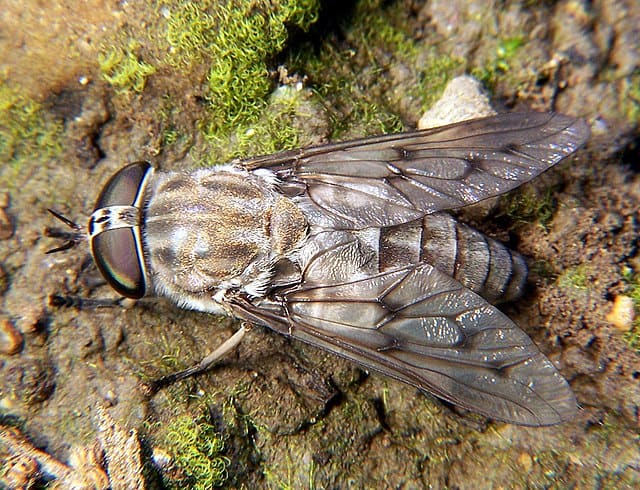
145 km/h
Horse-flies or horseflies are true flies in the family Tabanidae in the insect order Diptera. They are often large and agile in flight, and the females bite animals, including humans, to obtain blood. They prefer to fly in sunlight, avoiding dark and shady areas, and are inactive at night. They are found all over the world except for some islands and the polar regions (Hawaii, Greenland, Iceland). Both horse-flies and botflies (Oestridae) are sometimes referred to as gadflies.Adult horse-flies feed on nectar and plant exudates; the males have weak mouthparts and only the females bite animals to obtain enough protein from blood to produce eggs. The mouthparts of females are formed into a stout stabbing organ with two pairs of sharp cutting blades, and a spongelike part used to lap up the blood that flows from the wound. The larvae are predaceous and grow in semiaquatic habitats.
Female horse-flies can transfer blood-borne diseases from one animal to another through their feeding habit. In areas where diseases occur, they have been known to carry equine infectious anaemia virus, some trypanosomes, the filarial worm Loa loa, anthrax among cattle and sheep, and tularemia. They can reduce growth rates in cattle and lower the milk output of cows if suitable shelters are not provided.
Read More About Horse-fly / Source
Spur-winged goose
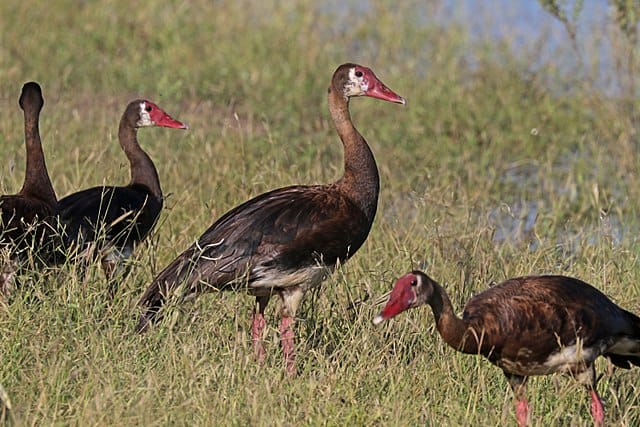
142 km/h
The spur-winged goose (Plectropterus gambensis) is a large bird in the family Anatidae, related to the geese and the shelducks, but distinct from both of these in a number of anatomical features, and therefore treated in its own subfamily, the Plectropterinae. It occurs in wetlands throughout sub-Saharan Africa. Adults are 75–115 cm (30–45 in) long and weigh on average 4–6.8 kg (8.8–15.0 lb), rarely up to 10 kg (22 lb), with males noticeably larger than the females. The wingspan can range from 150 to 200 cm (59 to 79 in).
Read More About Spur-winged goose / Source
Black marlin
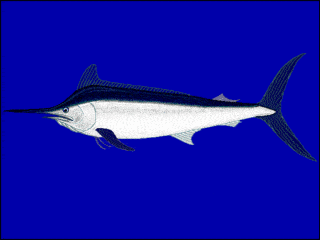
132 km/h
The black marlin (Istiompax indica) is a species of marlin found in tropical and subtropical areas of the Indian and Pacific Oceans. With a maximum published length of 4.65 m (15.3 ft) and weight of 750 kg (1,650 lb), it is one of the largest marlins and also one of the largest bony fish. Marlin are among the fastest fish, but speeds are often wildly exaggerated in popular media, such as reports of 120 ft/s (82 mph). Recent research suggests a burst speed of 36 kilometres per hour (22 mph) is near the maximum rate. Black marlin are fished commercially and are also a highly prized game fish.
Read More About Black marlin / Source
Red-breasted merganser
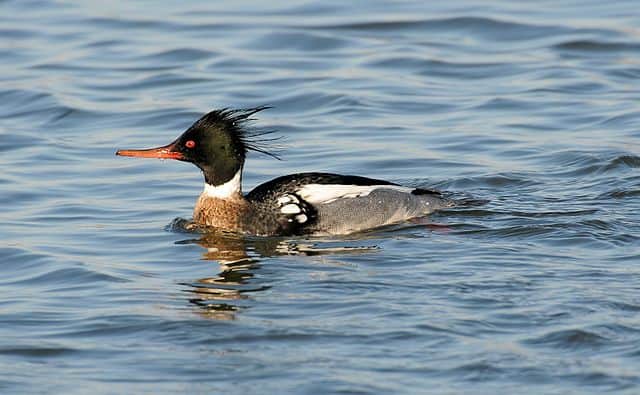
129 km/h
The red-breasted merganser (Mergus serrator) is a diving duck, one of the sawbills. The genus name is a Latin word used by Pliny and other Roman authors to refer to an unspecified waterbird, and serrator is a sawyer from Latin serra, “saw”. The red-breasted merganser was one of the many bird species originally described by Carl Linnaeus in his landmark 1758 10th edition of Systema Naturae, where it was given the binomial name Mergus serrator.
Read More About Red-breasted merganser / Source
Gyrfalcon
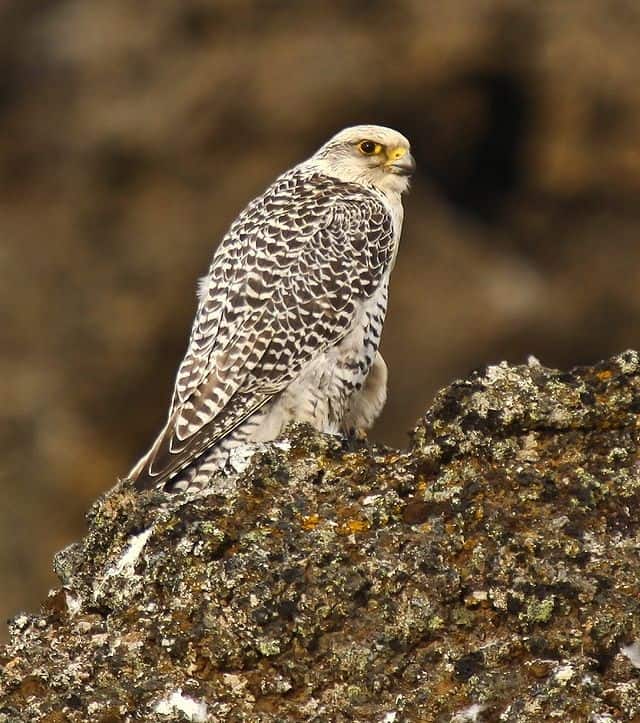
128 km/h
The gyrfalcon ( or ) (Falco rusticolus), the largest of the falcon species, is a bird of prey. The abbreviation gyr is also used. It breeds on Arctic coasts and tundra, and the islands of northern North America and the Eurosiberian region. It is mainly a resident there also, but some gyrfalcons disperse more widely after the breeding season, or in winter. Individual vagrancy can take birds for long distances. Its plumage varies with location, with birds being coloured from all-white to dark brown. These colour variations are called morphs. Like other falcons, it shows sexual dimorphism, with the female much larger than the male. For centuries, the gyrfalcon has been valued as a hunting bird. Typical prey includes the ptarmigan and waterfowl, which it may take in flight; it also takes fish and mammals.
Read More About Gyrfalcon / Source
Grey-headed albatross
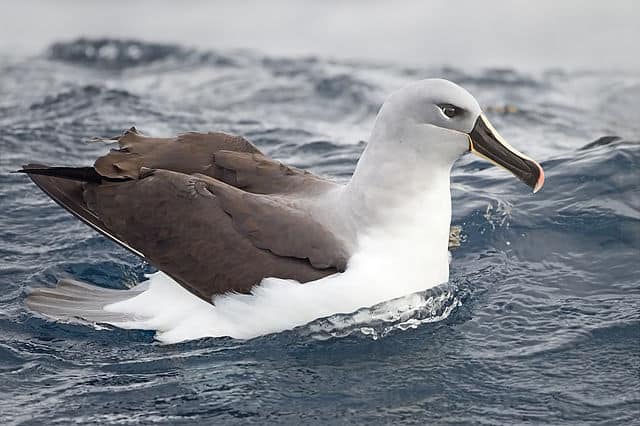
127 km/h
The grey-headed albatross (Thalassarche chrysostoma) also known as the grey-headed mollymawk, is a large seabird from the albatross family. It has a circumpolar distribution, nesting on isolated islands in the Southern Ocean and feeding at high latitudes, further south than any of the other mollymawks. Its name derives from its ashy-grey head, throat and upper neck.
Read More About Grey-headed albatross / Source
Cheetah

120 km/h
The cheetah (Acinonyx jubatus) is a large cat native to Africa and central Iran. It is the fastest land animal, estimated to be capable of running at 80 to 128 km/h (50 to 80 mph) with the fastest reliably recorded speeds being 93 and 98 km/h (58 and 61 mph), and as such has several adaptations for speed, including a light build, long thin legs and a long tail. It typically reaches 67–94 cm (26–37 in) at the shoulder, and the head-and-body length is between 1.1 and 1.5 m (3.6 and 4.9 ft). Adults weigh between 20 and 65 kg (44 and 143 lb). Its head is small, rounded, and has a short snout and black tear-like facial streaks. The coat is typically tawny to creamy white or pale buff and is mostly covered with evenly spaced, solid black spots. Four subspecies are recognised.
Read More About Cheetah / Source
Sailfish
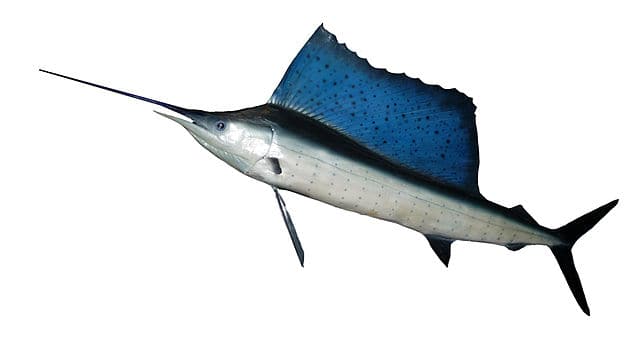
109 km/h
A sailfish is a fish of the genus Istiophorus of billfish living in colder areas of all Earth’s seas, and holds the record for the fastest speed of any of Earth’s marine animals. They are predominantly blue to gray in colour and have a characteristic dorsal fin known as a sail, which often stretches the entire length of the back. Another notable characteristic is the elongated bill, resembling that of the swordfish and other marlins. They are, therefore, described as billfish in sport-fishing circles.
Read More About Sailfish / Source
Anna's hummingbird
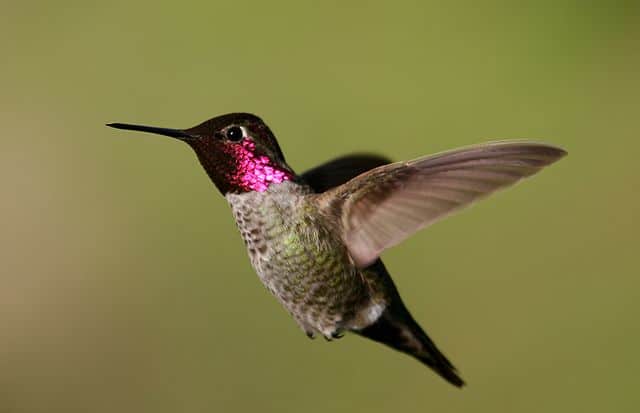
98 km/h
Anna’s hummingbird (Calypte anna) is a medium-sized bird species of the family Trochilidae. It was named after Anna Masséna, Duchess of Rivoli.It is native to western coastal regions of North America. In the early 20th century, Anna’s hummingbirds bred only in northern Baja California and southern California. The transplanting of exotic ornamental plants in residential areas throughout the Pacific coast and inland deserts provided expanded nectar and nesting sites, allowing the species to expand its breeding range.Anna’s hummingbird is 3.9 to 4.3 in (9.9 to 10.9 cm) long with a wingspan of 4.7 in (12 cm) and a weight range of 0.1-0.2 oz (3-6 g). It has an iridescent bronze-green back, a pale grey chest and belly, and green flanks. Its bill is long, straight, and slender. The adult male has an iridescent crimson-red derived from magenta to a reddish-pink crown and gorget, which can look dull brown or gray without direct sunlight and a dark, slightly forked tail. Females also have iridescent red gorgets, though they are usually smaller and less brilliant than the males’. Anna’s is the only North American hummingbird species with a red crown. Females and juvenile males have a dull green crown, a grey throat with or without some red iridescence, a grey chest and belly, and a dark, rounded tail with white tips on the outer feathers.
Read More About Anna's hummingbird / Source
Swordfish

97 km/h
Swordfish (Xiphias gladius), also known as broadbills in some countries, are large, highly migratory, predatory fish characterized by a long, flat, pointed bill. They are a popular sport fish of the billfish category, though elusive. Swordfish are elongated, round-bodied, and lose all teeth and scales by adulthood. These fish are found widely in tropical and temperate parts of the Atlantic, Pacific, and Indian Oceans, and can typically be found from near the surface to a depth of 550 m (1,800 ft), and exceptionally up to depths of 2,234 m. They commonly reach 3 m (9.8 ft) in length, and the maximum reported is 4.55 m (14.9 ft) in length and 650 kg (1,430 lb) in weight.They are the sole member of their family, Xiphiidae.
Read More About Swordfish / Source
Pronghorn

88.5 km/h
The pronghorn (Antilocapra americana) is a species of artiodactyl (even-toed, hoofed) mammal indigenous to interior western and central North America. Though not an antelope, it is often known colloquially in North America as the American antelope, prong buck, pronghorn antelope, prairie antelope, or simply antelope because it closely resembles the true antelopes of the Old World and fills a similar ecological niche due to parallel evolution. It is the only surviving member of the family Antilocapridae.During the Pleistocene epoch, about 11 other antilocaprid species existed in North America. Three other genera (Capromeryx, Stockoceros and Tetrameryx) existed when humans entered North America but are now extinct.
As a member of the superfamily Giraffoidea, the pronghorn’s closest living relatives are the giraffe and okapi. The Giraffoidea are in turn members of the infraorder Pecora, making pronghorns more distant relatives of the Cervidae (deer) and Bovidae (cattle, goats, sheep, antelopes, and gazelles), among others.
The pronghorn is the symbol of the American Society of Mammalogists.
Read More About Pronghorn / Source
Springbok

88 km/h
The springbok (Antidorcas marsupialis) is a medium-sized antelope found mainly in southern and southwestern Africa. The sole member of the genus Antidorcas, this bovid was first described by the German zoologist Eberhard August Wilhelm von Zimmermann in 1780. Three subspecies are identified. A slender, long-legged antelope, the springbok reaches 71 to 86 cm (28 to 34 in) at the shoulder and weighs between 27 and 42 kg (60 and 93 lb). Both sexes have a pair of black, 35-to-50 cm (14-to-20 in) long horns that curve backwards. The springbok is characterised by a white face, a dark stripe running from the eyes to the mouth, a light-brown coat marked by a reddish-brown stripe that runs from the upper fore leg to the buttocks across the flanks like the Thomson’s gazelle, and a white rump flap.
Active mainly at dawn and dusk, springbok form harems (mixed-sex herds). In earlier times, springbok of the Kalahari desert and Karoo migrated in large numbers across the countryside, a practice known as trekbokking.
Read More About Springbok / Source
American Quarter Horse
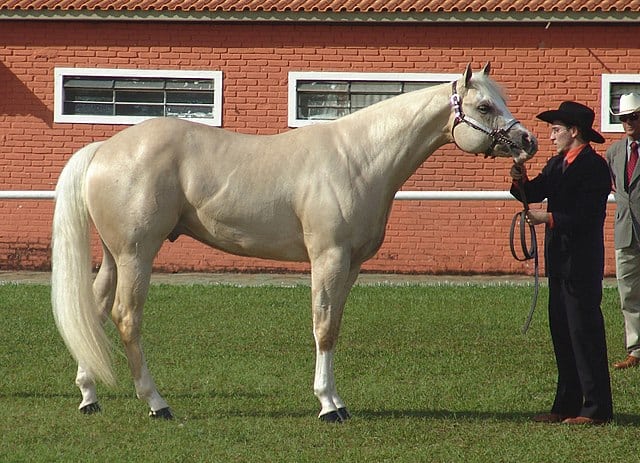
70 km/h
The American Quarter Horse, or Quarter Horse, is an American breed of horse that excels at sprinting short distances. Its name is derived from its ability to outrun other horse breeds in races of a quarter mile or less; some have been clocked at speeds up to 55 mph (88.5 km/h). The development of the Quarter Horse traces to the 1600s. The American Quarter Horse is the most popular breed in the United States today, and the American Quarter Horse Association is the largest breed registry in the world, with almost 3 million living American Quarter Horses registered in 2014. The American Quarter Horse is well known both as a race horse and for its performance in rodeos, horse shows and as a working ranch horse.
The compact body of the American Quarter Horse is well-suited for the intricate and quick maneuvers required in reining, cutting, working cow horse, barrel racing, calf roping, and other western riding events, especially those involving live cattle. The American Quarter Horse is also used in English disciplines, driving, show jumping, dressage, hunting, and many other equestrian activities.
Read More About American Quarter Horse / Source
Blue wildebeest

80.5 km/h
The blue wildebeest (Connochaetes taurinus), also called the common wildebeest, white-bearded wildebeest, or brindled gnu, is a large antelope and one of the two species of wildebeest. It is placed in the genus Connochaetes and family Bovidae, and has a close taxonomic relationship with the black wildebeest. The blue wildebeest is known to have five subspecies. This broad-shouldered antelope has a muscular, front-heavy appearance, with a distinctive, robust muzzle. Young blue wildebeest are born tawny brown, and begin to take on their adult coloration at the age of 2 months. The adults’ hues range from a deep slate or bluish-gray to light gray or even grayish-brown. Both sexes possess a pair of large curved horns.
Read More About Blue wildebeest / Source
Lion
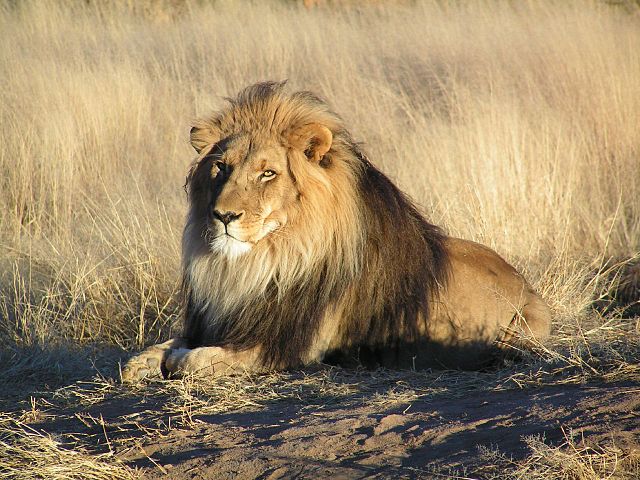
80.5 km/h
The lion (Panthera leo) is a species in the family Felidae and a member of the genus Panthera. It has a muscular, deep-chested body, short, rounded head, round ears, and a hairy tuft at the end of its tail. It is sexually dimorphic; adult male lions have a prominent mane. With a typical head-to-body length of 184–208 cm (72–82 in) they are larger than females at 160–184 cm (63–72 in). It is a social species, forming groups called prides. A lion pride consists of a few adult males, related females and cubs. Groups of female lions usually hunt together, preying mostly on large ungulates. The lion is an apex and keystone predator; although some lions scavenge when opportunities occur and have been known to hunt humans, the species typically does not.
Blackbuck
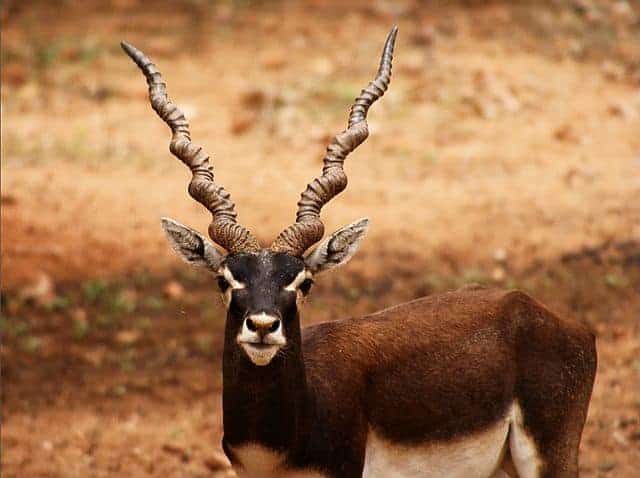
80 km/h
The blackbuck (Antilope cervicapra), also known as the Indian antelope, is an antelope native to India and Nepal. It inhabits grassy plains and lightly forested areas with perennial water sources. It stands up to 74 to 84 cm (29 to 33 in) high at the shoulder. Males weigh 20–57 kg (44–126 lb), with an average of 38 kg (84 lb). Females are lighter, weighing 20–33 kg (44–73 lb) or 27 kg (60 lb) on average. Males have 35–75 cm (14–30 in) long, ringed horns, though females may develop horns as well. The white fur on the chin and around the eyes is in sharp contrast with the black stripes on the face. The coats of males show a two-tone colouration; while the upper parts and outsides of the legs are dark brown to black, the underparts and the insides of the legs are white. Females and juveniles are yellowish fawn to tan. The blackbuck is the sole living member of the genus Antilope and was scientifically described by Carl Linnaeus in 1758. Two subspecies are recognized.
Read More About Blackbuck / Source
Thomson's gazelle
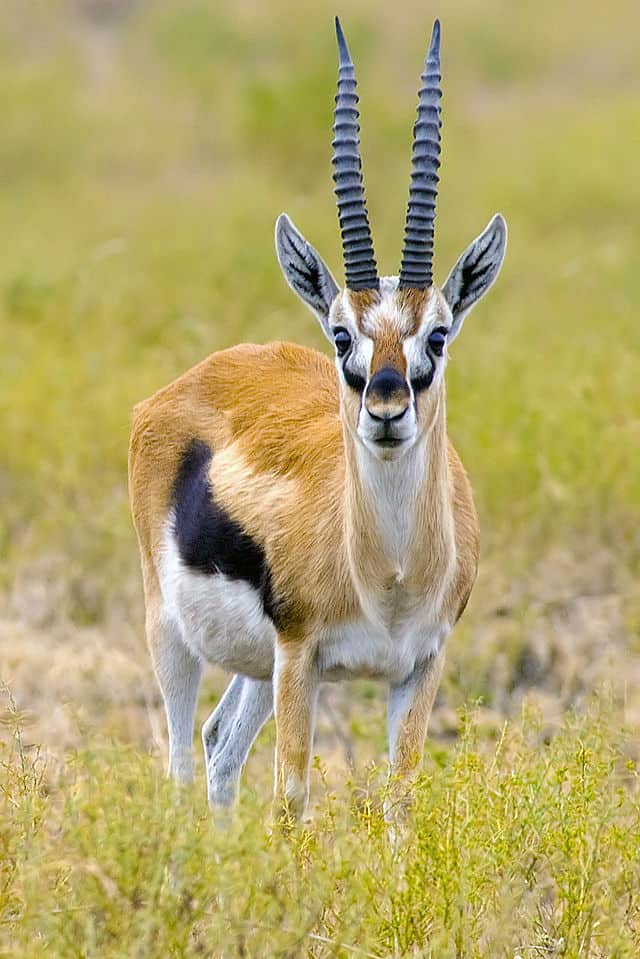
80 km/h
Thomson’s gazelle (Eudorcas thomsonii) is one of the best-known gazelles. It is named after explorer Joseph Thomson and is sometimes referred to as a “tommie”. It is considered by some to be a subspecies of the red-fronted gazelle and was formerly considered a member of the genus Gazella within the subgenus Eudorcas, before Eudorcas was elevated to genus status. Thomson’s gazelles can be found in numbers exceeding 200,000 in Africa and are recognized as the most common type of gazelle in East Africa. The Thomson’s gazelle can reach speeds of 80–90 km/h (50–55 mph). It is the fourth-fastest land animal, after the cheetah (its main predator), pronghorn, and springbok.
Read More About Thomson's gazelle / Source
Golden eagle
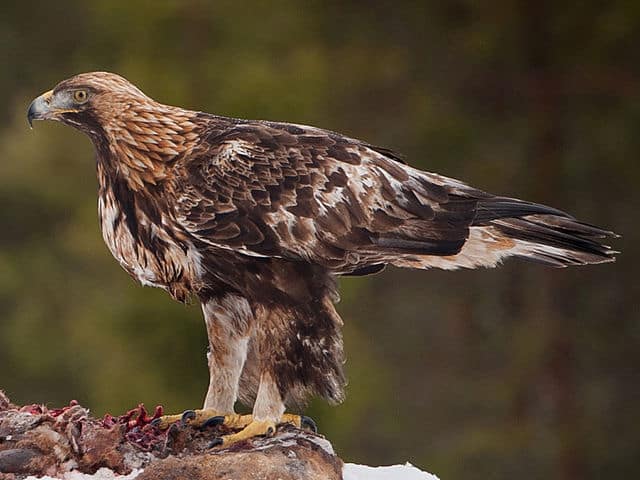
320 km/h
The golden eagle (Aquila chrysaetos) is one of the best-known birds of prey in the Northern Hemisphere. It is the most widely distributed species of eagle. Like all eagles, it belongs to the family Accipitridae. These birds are dark brown, with lighter golden-brown plumage on their napes. Immature eagles of this species typically have white on the tail and often have white markings on the wings. Golden eagles use their agility and speed combined with powerful feet and massive, sharp talons to snatch up a variety of prey, mainly hares, rabbits, and marmots and other ground squirrels.
Golden eagles maintain home ranges or territories that may be as large as 200 km2 (77 sq mi). They build large nests in cliffs and other high places to which they may return for several breeding years. Most breeding activities take place in the spring; they are monogamous and may remain together for several years or possibly for life. Females lay up to four eggs, and then incubate them for six weeks. Typically, one or two young survive to fledge in about three months. These juvenile golden eagles usually attain full independence in the fall, after which they wander widely until establishing a territory for themselves in four to five years.
Read More About Golden eagle / Source
Hare

80 km/h
Hares and jackrabbits are leporids belonging to the genus Lepus. Hares are classified in the same family as rabbits. They are similar in size to rabbits and have similar herbivorous diets, but generally have longer ears and live solitarily or in pairs. They do not dig burrows but nest in slight depressions called forms, often in long grass. Also unlike rabbits, their young are able to fend for themselves shortly after birth rather than emerging blind and helpless. Most are fast runners. Hare species are native to Africa, Eurasia and North America.
Yellowfin tuna

76 km/h
The yellowfin tuna (Thunnus albacares) is a species of tuna found in pelagic waters of tropical and subtropical oceans worldwide. Yellowfin is often marketed as ahi, from the Hawaiian ʻahi, a name also used there for the closely related bigeye tuna. The species name, albacares (“white meat”) can also lead to confusion: in English, the albacore (Thunnus alalunga) is a different species, while yellowfin is officially designated albacore in French and referred to as albacora by Portuguese fishermen. In Malayalam it is known as kera or manjha choora.
Read More About Yellowfin tuna / Source
Shortfin mako shark
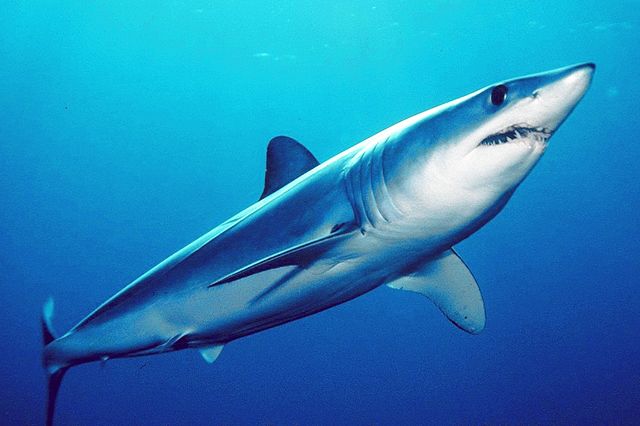
72 km/h
The shortfin mako shark (Isurus oxyrinchus), also known as the blue pointer or bonito shark, is a large mackerel shark. It is commonly referred to as the mako shark, as is the longfin mako shark (Isurus paucus). The shortfin mako can reach a size of 4 m (13 ft) in length. The species is classified as Endangered by the IUCN.
Read More About Shortfin mako shark / Source
Black-tailed jackrabbit
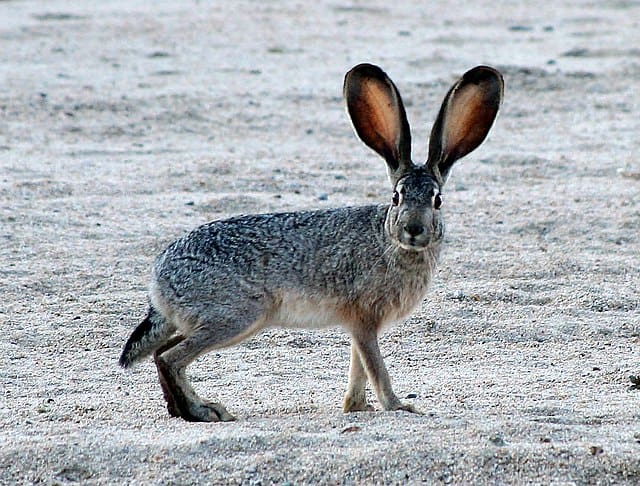
72 km/h
The black-tailed jackrabbit (Lepus californicus), also known as the American desert hare, is a common hare of the western United States and Mexico, where it is found at elevations from sea level up to 10,000 ft (3,000 m). Reaching a length around 2 ft (61 cm), and a weight from 3 to 6 lb (1.4 to 2.7 kg), the black-tailed jackrabbit is one of the largest North American hares. Black-tailed jackrabbits occupy mixed shrub-grassland terrains. Their breeding depends on the location; it typically peaks in spring, but may continue all year round in warm climates. Young are born fully furred with eyes open; they are well camouflaged and are mobile within minutes of birth, thus females do not protect or even stay with the young except during nursing. The average litter size is around four, but may be as low as two and as high as seven in warm regions.
The black-tailed jackrabbit does not migrate or hibernate during winter and uses the same habitat of 0.4 to 1.2 mi2 (1–3 km2) year-round. Its diet is composed of various shrubs, small trees, grasses, and forbs. Shrubs generally comprise the bulk of fall and winter diets, while grasses and forbs are used in spring and early summer, but the pattern and plant species vary with climate.
Read More About Black-tailed jackrabbit / Source
African wild dog
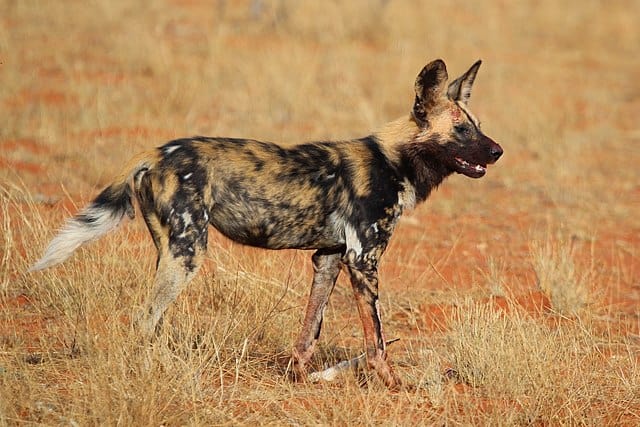
71 km/h
The African wild dog (Lycaon pictus) is a canine which is a native species to sub-Saharan Africa. It is the largest wild canine in Africa, and the only extant member of the genus Lycaon, which is distinguished from Canis by dentition highly specialised for a hypercarnivorous diet, and a lack of dewclaws. It is estimated that about 6,600 adults (including 1,400 mature individuals) live in 39 subpopulations that are all threatened by habitat fragmentation, human persecution and outbreaks of diseases. As the largest subpopulation probably consists of less than 250 individuals, the African wild dog has been listed as endangered on the IUCN Red List since 1990.The African wild dog is a highly social animal, living in packs with separate dominance hierarchies for males and females. Uniquely among social carnivores, the females rather than the males disperse from the natal pack once sexually mature. The young are allowed to feed first on carcasses. The species is a specialised diurnal hunter of antelopes, which it catches by chasing them to exhaustion. Like other canids, the African wild dog regurgitates food for its young, but this action is also extended to adults, to the point of being central to their social life. Its natural enemies are lions and hyenas: the former will kill the canids where possible, whilst hyenas are frequent kleptoparasites.Although not as prominent in African folklore or culture as other African carnivores, it has been respected in several hunter-gatherer societies, particularly those of the predynastic Egyptians and the San people.
Read More About African wild dog / Source
Kangaroo

71 km/h
The kangaroo is a marsupial from the family Macropodidae (macropods, meaning “large foot”). In common use the term is used to describe the largest species from this family, the red kangaroo, as well as the antilopine kangaroo, eastern grey kangaroo, and western grey kangaroo. Kangaroos are indigenous to Australia and New Guinea. The Australian government estimates that 34.3 million kangaroos lived within the commercial harvest areas of Australia in 2011, up from 25.1 million one year earlier.
Read More About Kangaroo / Source
Greyhound
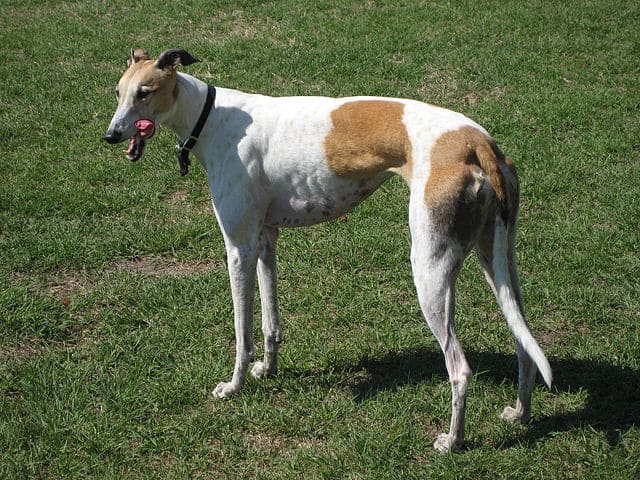
70 km/h
The Greyhound is a breed of dog, a sighthound which has been bred for coursing game and greyhound racing. It is also referred to as an English Greyhound. Since the rise in large-scale adoption of retired racing Greyhounds, the breed has seen a resurgence in popularity as a family pet.
According to Merriam-Webster, a Greyhound is “any of a breed of tall slender graceful smooth-coated dogs characterized by swiftness and keen sight”, as well as “any of several related dogs”, such as the Italian Greyhound.It is a gentle and intelligent breed whose combination of long, powerful legs, deep chest, flexible spine, and slim build allows it to reach average race speeds exceeding 64 kilometres per hour (40 mph). The Greyhound can reach a full speed of 70 kilometres per hour (43 mph) within 30 metres (98 ft), or six strides from the boxes, traveling at almost 20 metres per second (66 ft/s) for the first 250 metres (820 ft) of a race.
Read More About Greyhound / Source
Onager
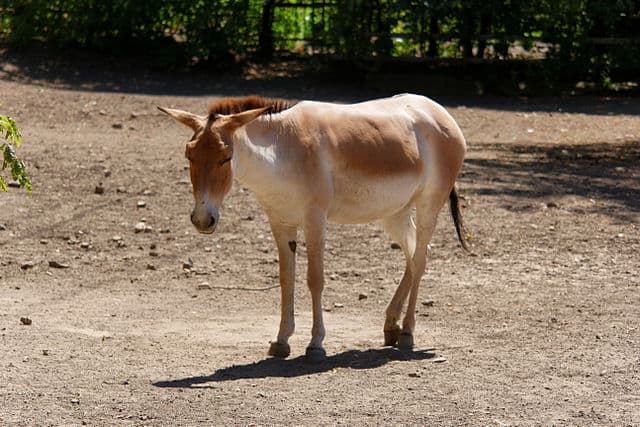
70 km/h
The onager (Equus hemionus), also known as hemione or Asiatic wild ass, is a species of the family Equidae (horse family) native to Asia. A member of the subgenus Asinus, the onager was described and given its binomial name by German zoologist Peter Simon Pallas in 1775. Five subspecies have been recognized, one of which is extinct.
The Asiatic wild ass is larger than the African wild ass at about 290 kg (640 lb) and 2.1 m (6.9 ft) (head-body length). They are reddish-brown or yellowish-brown in color and have broad dorsal stripe on the middle of the back. Unlike most horses and donkeys, onagers have never been domesticated. They are among the fastest mammals, as they can run as fast as 64 km/h (40 mph) to 70 km/h (43 mph). The onager is closely related to the African wild ass, as they both shared the same ancestor. The kiang, formerly considered a subspecies of Equus hemionus, diverged from the Asiatic wild ass and has been acknowledged as a distinct species.The onager formerly had a wider range from southwest and central to northern Asian countries, such as Israel, Saudi Arabia, Iraq, Jordan, Syria, Afghanistan, Russia, and Siberia, the prehistoric European wild ass subspecies ranged through Europe until the Bronze age. During early 20th century, the species lost most of its ranges in the Middle East and Eastern Asia.
Read More About Onager / Source
Coyote
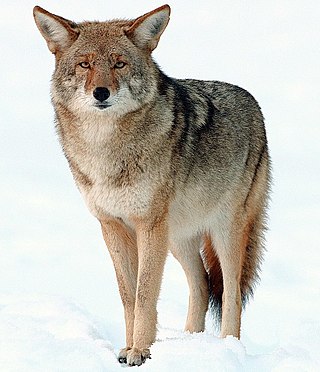
65 km/h
The coyote (Canis latrans) is a species of canine native to North America. It is smaller than its close relative, the wolf, and slightly smaller than the closely related eastern wolf and red wolf. It fills much of the same ecological niche as the golden jackal does in Eurasia. The coyote is larger and more predatory and was once referred to as the American jackal by a behavioral ecologist. Other historical names for the species include the prairie wolf and the brush wolf.
Read More About Coyote / Source
Big brown bat

64 km/h
The big brown bat (Eptesicus fuscus) is a species of vesper bat distributed widely throughout North America, the Caribbean, and the northern portion of South America. It was first described as a species in 1796. Compared to other microbats, the big brown bat is relatively large, weighing 15–26 g (0.53–0.92 oz) and possessing a wingspan of 32.5–35 cm (12.8–13.8 in). Big brown bats are insectivorous, consuming a diverse array of insects, particularly night-flying insects, but especially beetles. Some of the beetles it consumes are serious agricultural pests, including cucumber beetles. They are nocturnal, foraging for prey at night and roosting in sheltered areas during the day such as caves, tunnels, tree cavities, and human structures. Their breeding season is in the fall, shortly before their annual hibernation. After hibernation ends in the spring, females form maternity colonies for giving birth to young. Oftentimes only one offspring is produced per litter, though twins are common in the Eastern US. Lifespans of 6.5 years are considered average. The big brown bat occurs widely throughout the US, Canada, Central America, and the Caribbean. Its range extends into parts of South America, found as far south as Colombia and Venezuela.
Read More About Big brown bat / Source
Common dolphin
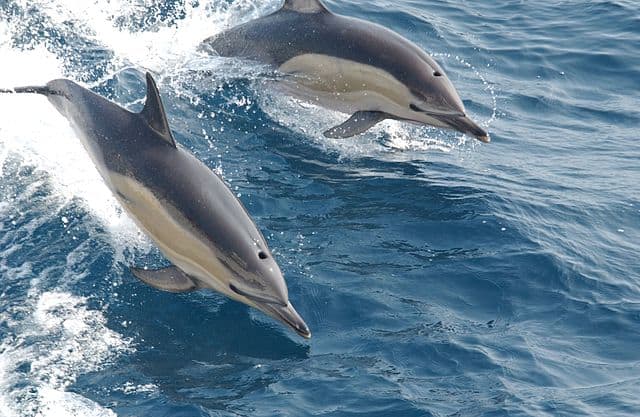
64 km/h
The common dolphin is the most abundant cetacean in the world, with a global population of about six million. Despite this fact, the common dolphin is not thought of as the archetypal dolphin, with that distinction belonging to the bottlenose dolphin due to its popular appearances in aquaria and the media. However, the common dolphin is often depicted in Ancient Greek and Roman art and culture, most notably in a mural painted by the Greek Minoan civilization.The common dolphin belongs to the subfamily Delphininae, making this dolphin closely related to the three different species of bottlenose dolphins, humpback dolphins, striped dolphins, spinner dolphins, clymene dolphin, spotted dolphins, fraser’s dolphin and the tucuxi and guiana dolphin. The common dolphin was originally categorized into two different species, the short-beaked common dolphin and the long-beaked common dolphin. However, recent evidence has shown that many populations of long-beaked common dolphins around the world are not closely related to one another and are often derived from a short-beaked ancestor and do not always share common derived characteristics. For this reason, they are no longer considered different species.
Read More About Common dolphin / Source
Zebra
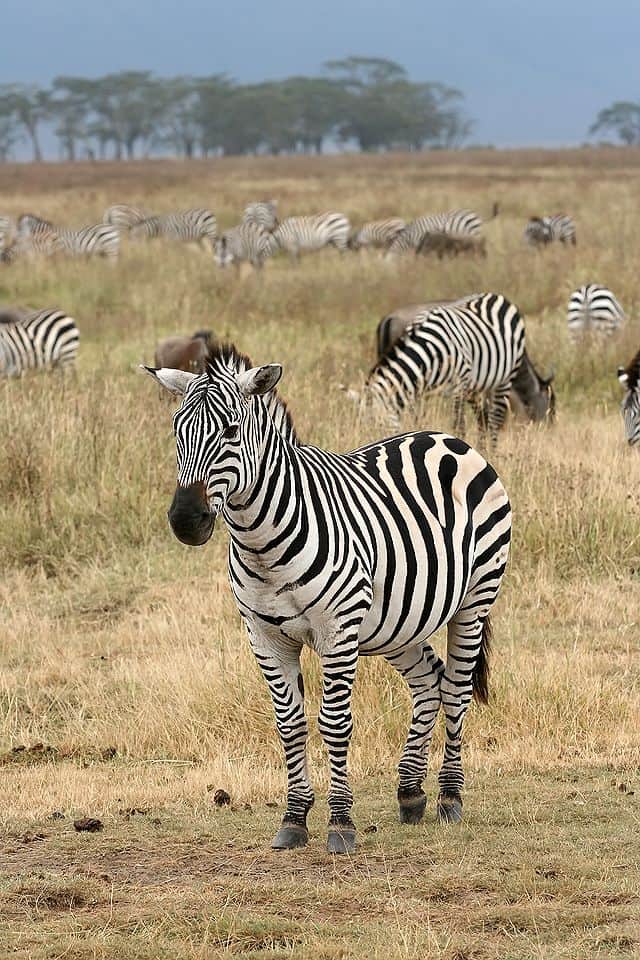
64 km/h
Zebras (subgenus Hippotigris) are African equines with distinctive black-and-white striped coats. There are three extant species: the Grévy’s zebra (Equus grevyi), plains zebra (E. quagga), and the mountain zebra (E. zebra). Zebras share the genus Equus with horses and asses, the three groups being the only living members of the family Equidae. Zebra stripes come in different patterns, unique to each individual. Several theories have been proposed for the function of these stripes, with most evidence supporting them as a form of protection from biting flies. Zebras inhabit eastern and southern Africa and can be found in a variety of habitats such as savannahs, grasslands, woodlands, shrublands, and mountainous areas.
Read More About Zebra / Source
Tiger
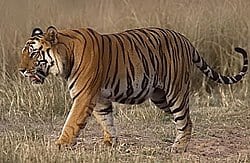
64 km/h
The tiger (Panthera tigris) is the largest living cat species and a member of the genus Panthera. It is most recognisable for its dark vertical stripes on orange-brown fur with a lighter underside. It is an apex predator, primarily preying on ungulates such as deer and wild boar. It is territorial and generally a solitary but social predator, requiring large contiguous areas of habitat, which support its requirements for prey and rearing of its offspring. Tiger cubs stay with their mother for about two years, before they become independent and leave their mother’s home range to establish their own.
Read More About Tiger / Source
Hyena
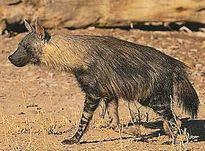
60 km/h
Hyenas, or hyaenas (from Ancient Greek ὕαινα, hýaina), are feliform carnivoran mammals of the family Hyaenidae /haɪˈɛnɪdiː/. With only four extant species (in three genera), it is the fifth-smallest biological family in the Carnivora and one of the smallest in the class Mammalia. Despite their low diversity, hyenas are unique and vital components of most African ecosystems.
Although phylogenetically closer to felines and viverrids, as part of suborder Feliformia, hyenas are behaviourally and morphologically similar to canids in several elements due to convergent evolution; both hyenas and canines are non-arboreal, cursorial hunters that catch prey with their teeth rather than claws. Both eat food quickly and may store it, and their calloused feet with large, blunt, nonretractable claws are adapted for running and making sharp turns. However, hyenas’ grooming, scent marking, defecation habits, mating and parental behaviour are consistent with the behaviour of other feliforms.
Read More About Hyena / Source





